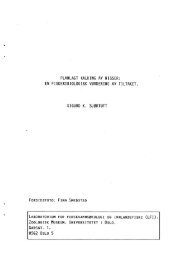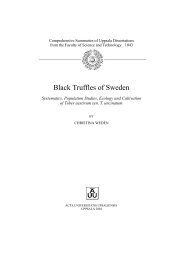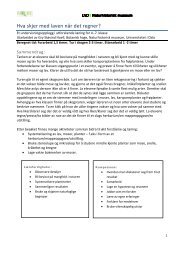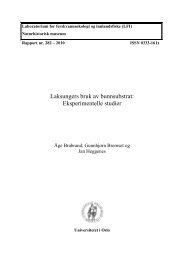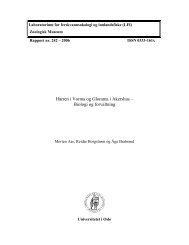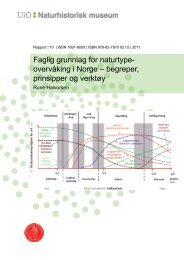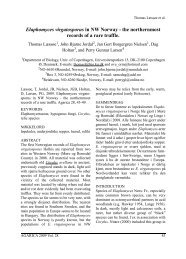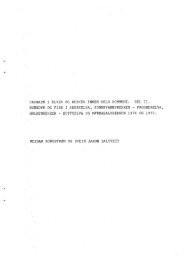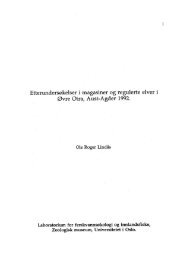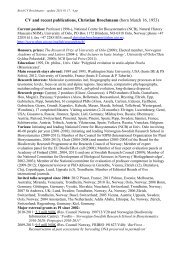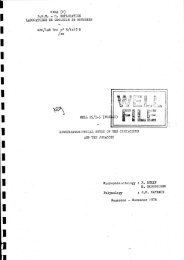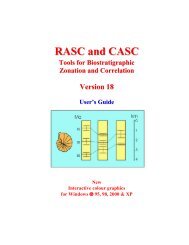Truffle trouble: what happened to the Tuberales?
Truffle trouble: what happened to the Tuberales?
Truffle trouble: what happened to the Tuberales?
- TAGS
- truffle
- www.nhm.uio.no
You also want an ePaper? Increase the reach of your titles
YUMPU automatically turns print PDFs into web optimized ePapers that Google loves.
1086 T. Læssøe, K. Hansen<br />
based on <strong>the</strong> amyloid asci. Our analyses place Tirmania in <strong>the</strong><br />
P. depressa–Ruhlandiella lineage.<br />
Lineage B<br />
The monotypic, parasitic Rhizinaceae and Caloscyphaceae have<br />
no known hypogeous representatives. <strong>Truffle</strong>s forming<br />
ptycho<strong>the</strong>cia and stereo<strong>the</strong>cia are identified in both <strong>the</strong><br />
Morchellaceae–Discinaceae and Helvellaceae–Tuberaceae lineages<br />
(Figs 3, 6A-H). The family Tuberaceae is unique in its high diversity<br />
of strictly hypogeous taxa.<br />
Morchellaceae–Discinaceae<br />
O’Donnell et al. (1997) placed Leucangium and Fischerula as<br />
incertae sedis due <strong>to</strong> suspected long-branch attraction between<br />
<strong>the</strong>se taxa. Additional sampling of hypogeous taxa in this<br />
group, including <strong>the</strong> type species of Fischerula, could possibly<br />
help resolve this problem.<br />
Fischerula Mattir. 1928 (Fig 6A)<br />
Type: Fischerula macrospora.<br />
Mattirolo (1928) and Knapp (1951) separated Fischerula from<br />
Tuber based on <strong>the</strong> peculiar spore ornamentation and <strong>the</strong><br />
more or less fusiform asci. Trappe (1975b, 1979) placed Fischerula<br />
in <strong>the</strong> Helvellaceae, a placement that can be rejected as long<br />
as <strong>the</strong> two known species are considered congeneric. The<br />
ascoma of <strong>the</strong> American taxon, F. subcaulis, has a stipe-like<br />
extension, as <strong>the</strong> name indicates, which is absent on <strong>the</strong><br />
European taxon.<br />
Leucangium Quél. 1883<br />
Type: Leucangium ophthalmosporum (syn. L. carthusianum).<br />
Li (1997) studied <strong>the</strong> ultrastructure of Leucangium carthusianum,<br />
often treated within Picoa, and found it <strong>to</strong> be close <strong>to</strong> species<br />
in Morchellaceae and Helvellaceae. The structure of <strong>the</strong><br />
excipulum also indicated such a relationship. Li found <strong>the</strong> ascospores<br />
<strong>to</strong> be multi-nucleate, which would point <strong>to</strong>wards <strong>the</strong><br />
Morchellaceae ra<strong>the</strong>r than <strong>the</strong> Helvellaceae. Likewise, O’Donnell<br />
et al. (1997) found that L. carthusianum clustered in <strong>the</strong> neighbourhood<br />
of <strong>the</strong> Morchellaceae, while <strong>the</strong> type of Picoa clustered<br />
with Otidea (Pyronemataceae) (data not shown in O’Donnell et al.<br />
1997). L. carthusianum has apiculate-fusiform ascospores in<br />
saccate asci. Palfner & Agerer (1998b) described <strong>the</strong> ec<strong>to</strong>mycorrhizae<br />
of this species.<br />
Discinaceae Benedix 1961 (syn. Hydnotryaceae M. Lange 1956)<br />
Besides <strong>the</strong> epigeous taxa Discina, Pseudorhizina and Gyromitra,<br />
this family also includes <strong>the</strong> hypogeous taxon Hydnotrya<br />
(O’Donnell et al. 1997)(Figs 3, and 6C-D). The family name Hydnotryaceae<br />
has been used <strong>to</strong> replace Pseudotuberaceae (nom.<br />
inval., Art. 36.1) (e.g. Burdsall 1968), but is itself invalid (no<br />
Latin nor any o<strong>the</strong>r kind of diagnosis, e.g. Art. 36.1).<br />
Hydnotrya Berk. & Broome 1846 (syn. Geoporella, Gyrocratera)<br />
(Figs 6C-D)<br />
Type: Hydnotrya tulasnei.<br />
Knapp (1950, 1952) discussed <strong>the</strong> genus, including <strong>the</strong> synonym<br />
Geoporella, and gave a fairly detailed description, whilst<br />
a thorough key with a few misplaced taxa can be found in<br />
Gilkey (1954). Trappe (1975c) dealt with <strong>the</strong> generic names<br />
Geoporella and Gyrocratera. Trappe (1979), Donadini (1986b)<br />
and later Abbott & Currah (1997) accepted <strong>the</strong> genus in <strong>the</strong><br />
Helvellaceae, which cannot be confirmed by <strong>the</strong> molecular<br />
data. Donadini (1986a) reported 4-nucleate spores. The morphological<br />
variation within <strong>the</strong> genus spans more or less hollow<br />
ascomata with cylindrical asci <strong>to</strong> nearly solid ascomata<br />
(Figs 6C-D) with clavate-saccate asci. There is likewise a great<br />
variation in spore shape and ornamentation. Whe<strong>the</strong>r <strong>the</strong> variation<br />
in spore characters should be given taxonomic importance<br />
in generic assignment awaits fur<strong>the</strong>r molecular data.<br />
Zhang (1991b) demonstrated that <strong>the</strong>re is a conspicuous, but<br />
non-functional, opening in <strong>the</strong> ascus apex of H. cerebriformis.<br />
Gymnohydnotrya B.C. Zhang & Minter 1989<br />
Type: Gymnohydnotrya australiana.<br />
Zhang & Minter (1989b) accepted three Australian species<br />
and placed <strong>the</strong> genus in <strong>the</strong> Helvellaceae based on <strong>the</strong> four nuclei<br />
in <strong>the</strong> spores. The main diagnostic feature was <strong>the</strong> lack of<br />
a peridium, an external, and in <strong>the</strong> type species also internal<br />
hymenium, and <strong>the</strong> non-pigmented spores with an unusual<br />
and intricate ornamentation (a complex reticulum) as<br />
revealed by SEM. Vizzini (2003) lists this genus in <strong>the</strong> Discinaceae<br />
based on <strong>the</strong> similarity <strong>to</strong> Hydnotrya and <strong>the</strong> 4-nucleate<br />
ascospores. There are no published LSU sequences available<br />
for phylogenetic analysis. Two of <strong>the</strong> species had previously<br />
been placed in Sphaerozone (Bea<strong>to</strong>n & Weste 1978).<br />
Helvellaceae Fr. 1823 (syn. Balsamiaceae E. Fisch. 1897)<br />
The Balsamiaceae, a family accepted in an emended version<br />
by Trappe (1979) and by e.g. Pegler et al. (1993), were considered<br />
a synonym of <strong>the</strong> Helvellaceae by van Brummelen (in<br />
Dissing & Schumacher 1994) and in an emended version by<br />
O’Donnell et al. (1997), a conclusion that was followed by<br />
e.g. Eriksson & Winka (1998) and Hansen & Knudsen (2000).<br />
Analyses of LSU identified a Balsamia–Barssia lineage (PB 91 %<br />
and PP 100 %) as a poorly supported sister group <strong>to</strong> a<br />
Helvella–Wynnella lineage (Fig 3). However, this relationship<br />
was highly supported in combined analyses of LSU and SSU<br />
(PB 100 %, O’Donnell et al. 1997; Hansen & Pfister 2007).<br />
Balsamia Vittad. 1831 (syn. Pseudobalsamia E. Fisch.) (Fig 6E)<br />
Type (lec<strong>to</strong>): Balsamia vulgaris.<br />
Knapp (1950) gave a detailed account of this genus, which he<br />
placed in ‘section B’ of his own (invalid; Art. 36.1) family<br />
Pseudotuberaceae, but he later (Knapp 1952) placed it in his<br />
‘Eu-tuberaceae’, based on fur<strong>the</strong>r developmental studies; a<br />
conclusion also reached by Hawker (1954). Donadini (1986b) observed<br />
four nuclei in mature spores and proposed a placement<br />
in <strong>the</strong> Helvellaceae. The asci can be more or less organized in<br />
a palisade-like structure. Morphologically, Balsamia species<br />
are typical truffles with closed fruit bodies with a veined interior<br />
and a coarse peridium (Fig 6E). The asci are sac-like with<br />
clustered spores. The spore morphology is simple as in many<br />
species of Helvella. Species delimitation has been a subject of<br />
discussion with Szemere (1965) taking a very broad view.<br />
Trappe (1975c) agreed that Pseudobalsamia should be placed in<br />
synonymy with Balsamia. Palfner & Agerer (1998a) described<br />
<strong>the</strong> ec<strong>to</strong>mycorrhiza formed between B. alba and Pseudotsuga.<br />
Barssia Gilkey 1925<br />
Type: Barssia oregonensis.



